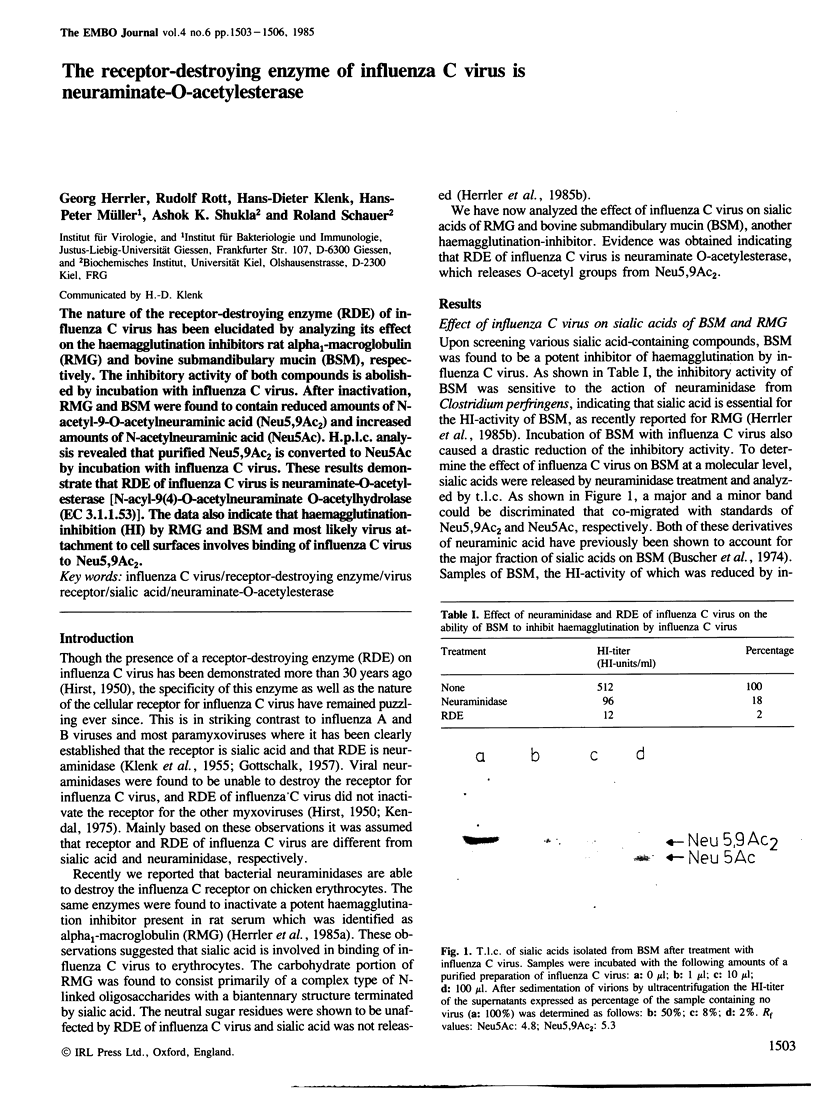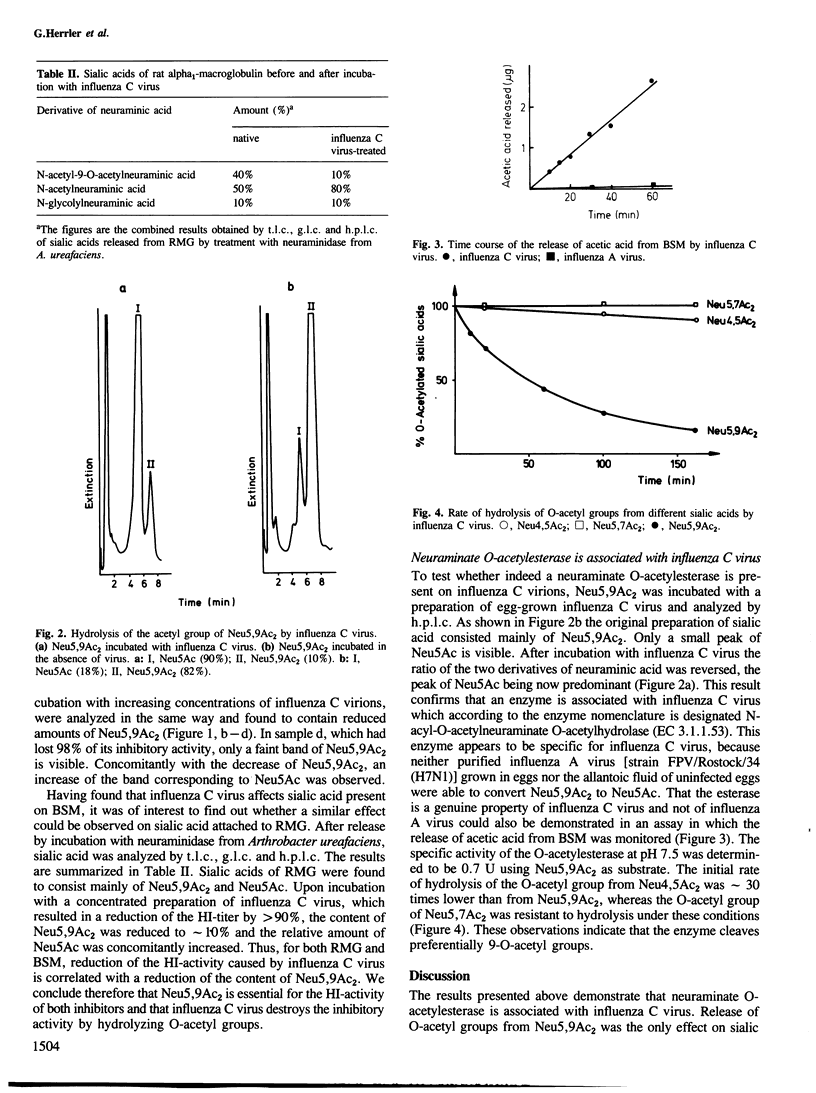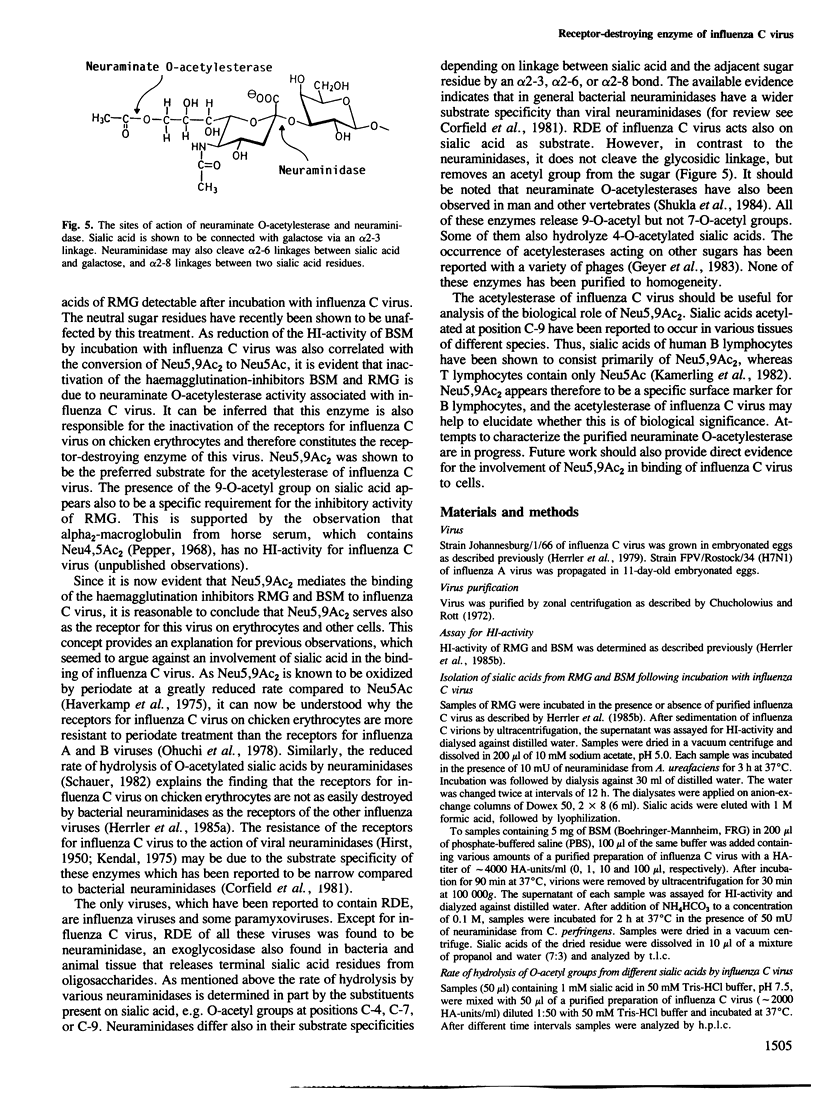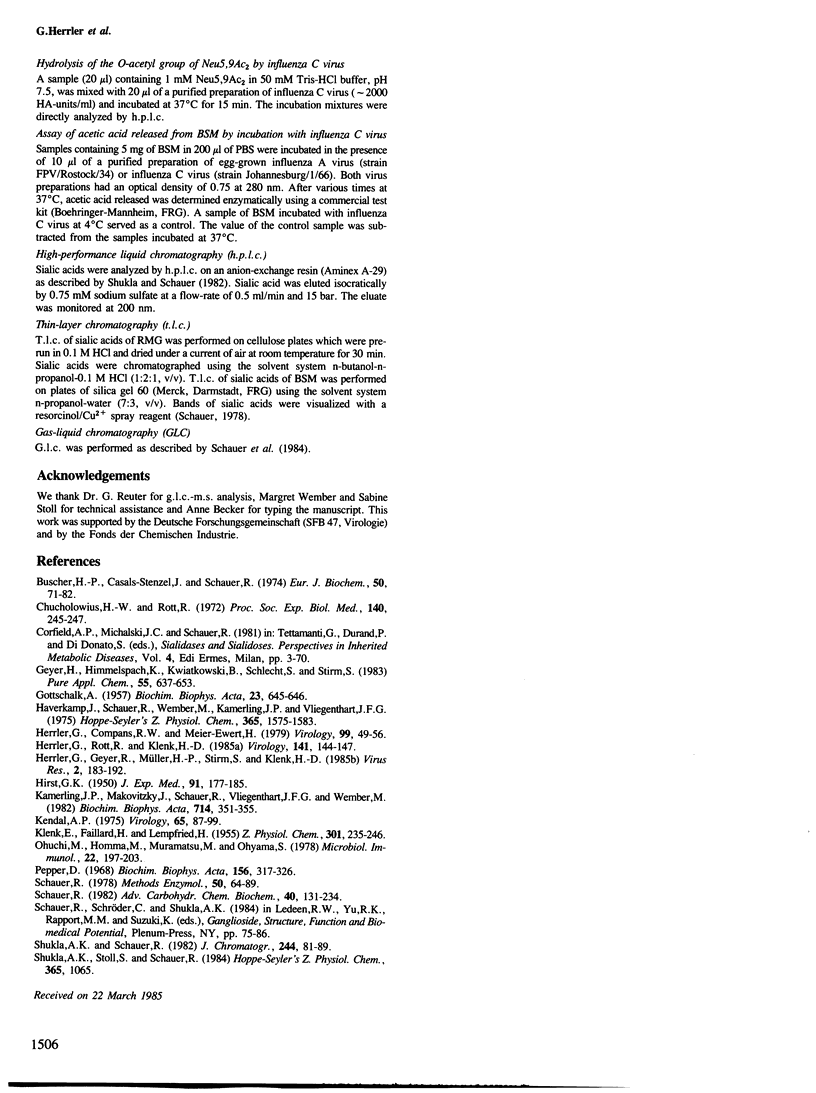Abstract
The nature of the receptor-destroying enzyme (RDE) of influenza C virus has been elucidated by analyzing its effect on the haemagglutination inhibitors rat alpha 1-macroglobulin (RMG) and bovine submandibulary mucin (BSM), respectively. The inhibitory activity of both compounds is abolished by incubation with influenza C virus. After inactivation, RMG and BSM were found to contain reduced amounts of N-acetyl-9-O-acetylneuraminic acid (Neu5,9Ac2) and increased amounts of N-acetylneuraminic acid (Neu5Ac). H.p.l.c. analysis revealed that purified Neu5,9Ac2 is converted to Neu5Ac by incubation with influenza C virus. These results demonstrate that RDE of influenza C virus is neuraminate-O-acetylesterase [N-acyl-9(4)-O-acetylneuraminate O-acetylhydrolase (EC 3.1.1.53)]. The data also indicate that haemagglutination-inhibition (HI) by RMG and BSM and most likely virus attachment to cell surfaces involves binding of influenza C virus to Neu5,9Ac2.
Full text
PDF



Images in this article
Selected References
These references are in PubMed. This may not be the complete list of references from this article.
- Buscher H. P., Casals-Stenzel J., Schaufer R. New sialic acids. Identification of N-glycoloyl-O-acetylneuraminic acids and N-acetyl-O-glycoloylneuraminic acids by improved methods for detection of N-acyl and O-acyl groups and by gas-liquid chromatography. Eur J Biochem. 1974 Dec 16;50(1):71–82. doi: 10.1111/j.1432-1033.1974.tb03873.x. [DOI] [PubMed] [Google Scholar]
- Chucholowius H. W., Rott R. A new method for purification of myxoviruses by zonal centrifugation with two different sucrose density gradients. Proc Soc Exp Biol Med. 1972 May;140(1):245–247. doi: 10.3181/00379727-140-36434. [DOI] [PubMed] [Google Scholar]
- GOTTSCHALK A. Neuraminidase: the specific enzyme of influenza virus and Vibrio cholerae. Biochim Biophys Acta. 1957 Mar;23(3):645–646. doi: 10.1016/0006-3002(57)90389-x. [DOI] [PubMed] [Google Scholar]
- HIRST G. K. The relationship of the receptors of a new strain of virus to those of the mumps-NDV-influenza group. J Exp Med. 1950 Feb;91(2):177–184. doi: 10.1084/jem.91.2.177. [DOI] [PMC free article] [PubMed] [Google Scholar]
- Haverkamp J., Schauer R., Wember M., Kamerling J. P., Vliegenthart J. F. Synthesis of 9-O-acetyl- and 4,9-di-O-acetyl derivatives of the methyl ester of N-acetyl-beta-D-neuraminic acid methylglycoside. Their use as models in periodate oxidation studies. Hoppe Seylers Z Physiol Chem. 1975 Oct;356(10):1575–1583. doi: 10.1515/bchm2.1975.356.2.1575. [DOI] [PubMed] [Google Scholar]
- Herrler G., Compans R. W., Meier-Ewert H. A precursor glycoprotein in influenza C virus. Virology. 1979 Nov;99(1):49–56. doi: 10.1016/0042-6822(79)90035-7. [DOI] [PubMed] [Google Scholar]
- Herrler G., Geyer R., Müller H. P., Stirm S., Klenk H. D. Rat alpha 1 macroglobulin inhibits hemagglutination by influenza C virus. Virus Res. 1985 Mar;2(2):183–192. doi: 10.1016/0168-1702(85)90248-5. [DOI] [PubMed] [Google Scholar]
- Herrler G., Rott R., Klenk H. D. Neuraminic acid is involved in the binding of influenza C virus to erythrocytes. Virology. 1985 Feb;141(1):144–147. doi: 10.1016/0042-6822(85)90190-4. [DOI] [PubMed] [Google Scholar]
- KLENK E., FAILLARD H., LEMPFRID H. Uber die enzymatische Wirkung von Influenzavirus. Hoppe Seylers Z Physiol Chem. 1955 Sep 2;301(4-6):235–246. [PubMed] [Google Scholar]
- Kamerling J. P., Makovitzky J., Schauer R., Vliegenthart J. F., Wember M. The nature of sialic acids in human lymphocytes. Biochim Biophys Acta. 1982 Feb 2;714(2):351–355. doi: 10.1016/0304-4165(82)90344-0. [DOI] [PubMed] [Google Scholar]
- Kendal A. P. A comparison of "influenza C" with prototype myxoviruses: receptor-destroycing activity (neuraminidase) and structural polypeptides. Virology. 1975 May;65(1):87–99. doi: 10.1016/0042-6822(75)90009-4. [DOI] [PubMed] [Google Scholar]
- Ohuchi M., Homma M., Muramatsu M., Ohyama S. Properties of the erythrocyte receptors for influenza C virus. Microbiol Immunol. 1978;22(4):197–203. doi: 10.1111/j.1348-0421.1978.tb00363.x. [DOI] [PubMed] [Google Scholar]
- Pepper D. S. The sialic acids of horse serum with special reference to their virus inhibitory properties. Biochim Biophys Acta. 1968 Mar 11;156(2):317–326. doi: 10.1016/0304-4165(68)90261-4. [DOI] [PubMed] [Google Scholar]
- Schauer R. Characterization of sialic acids. Methods Enzymol. 1978;50:64–89. doi: 10.1016/0076-6879(78)50008-6. [DOI] [PubMed] [Google Scholar]
- Schauer R. Chemistry, metabolism, and biological functions of sialic acids. Adv Carbohydr Chem Biochem. 1982;40:131–234. doi: 10.1016/s0065-2318(08)60109-2. [DOI] [PubMed] [Google Scholar]



